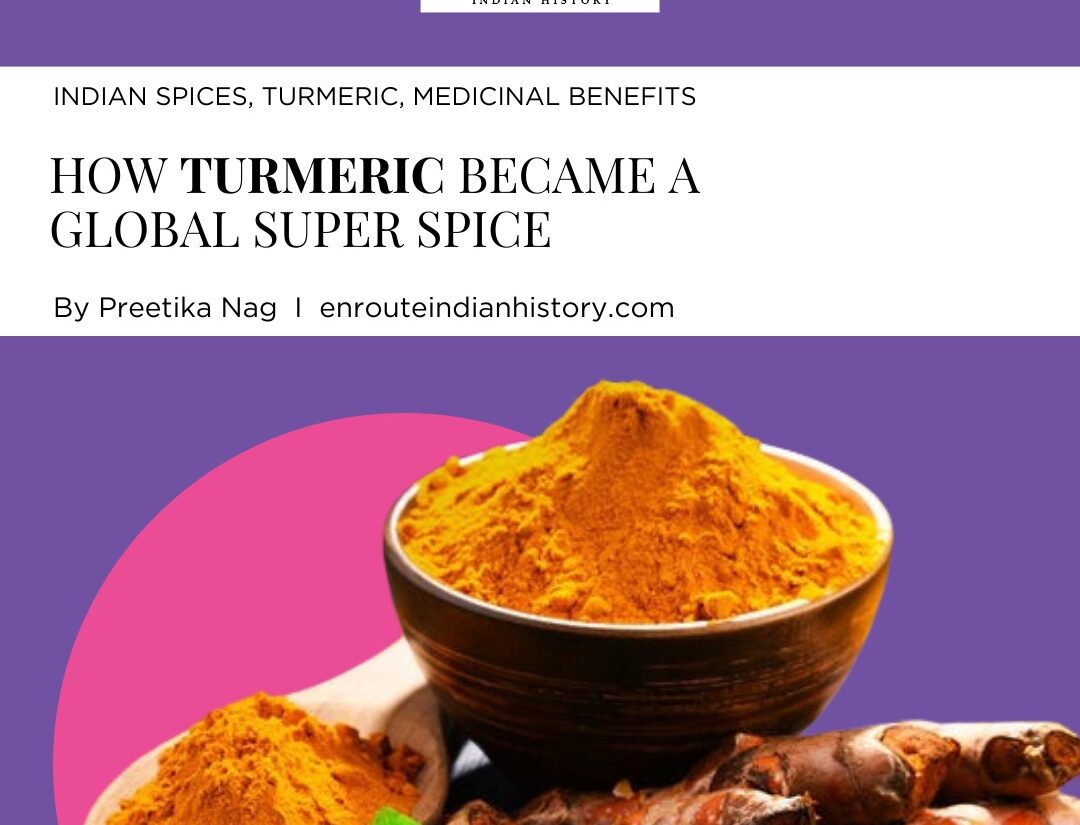
In the large pantheon of Indian Spices, the wonders of Turmeric are not unbeknownst to us entirely. Whether as a modern global spice or its traditional medicinal and health benefits turmeric adopts a multi-faceted character in the 21st century global village. The commercialization of Turmeric to such a large extent is a phenomenon of its kind with especially the cosmetic and pharmaceutical brands advertising its properties as saleable antics. Who can forget the famous jingles from our childhood – “Vicco Turmeric nahi cosmetic, Vicco Turmeric Ayurvedic Cream.” Although the benefits of the plant, as a quintessential Indian spice as well as its medicinal benefits, have been latently passed on and known to us Indians since the Vedic Age the recent trend of turmeric latte and turmeric face wash does raise the curiosity of this simple yellow compound and the properties that make it an asset to the commercial prospects of two big industries today- cosmetics and pharmaceuticals- that rely heavily on its medicinal benefits.

(FIG.1. TURMERIC: The Golden Spice. SOURCE: https://stock.adobe.com/in/search?k=turmeric)
HISTORICAL USE OF TURMERIC IN INDIA
The nomenclature for the turmeric plant that is most widely used is the Curcuma Longa or the Curcuma domestica, the term Curcuma being the active ingredient in the chemical composition which gives it the yellow color. The origins of the plant are usually located in the South Asian continent, but the exact geography is not well known although many suspect Indian subcontinental origins. The Indian subcontinent has been acquainted with Turmeric since the Vedic Age as found in the Atharva Veda, as well as in the ancient texts of Charaka Samhita and Sushruta Samhita which are the most revered Ayurvedic texts around. The rhizome, i.e. the underground root of the plant, has been the most useful for human consumption as an Indian spice as well as in its medicinal benefits. In Sanskrit, it is mainly known as Haridra, and initially, many foreign travelers to ancient and medieval India dubbed this bright yellow compound as ‘Indian Saffron,’ due to its initial usage as a dye for holy clothes. Today, it is commonly known as Haldi in the Indian vernacular, and even as a global Indian spice.

(FIG.2. CHARAKA who wrote the Charaka Samhita, an ancient Indian handbook on Ayurveda. SOURCE: https://technoayurveda.com/tangents-of-charakas-arc/)
The traditional uses of the turmeric plant are associated with its consumption mainly for its medicinal benefits as our ancient forefathers had realized the potential of this simple root that looked like ginger. In the Ayurvedic knowledge system, turmeric is known for its health benefits in maintaining the three physiological parameters – Vatta, Pita, and Kapha – that ensure optimal health of any individual. Ayurvedic texts contain over a hundred uses of turmeric for medicinal benefits. In traditional medicine, turmeric was an important ingredient to be used in several concoctions to treat allergies, colds, and coughs, a variety of pediatric issues, to enhance mental agility and prevent mental diseases, to treat fungal and/or bacterial infections of various organs, to maintain reproductive health in women, to treat poisonous bites of animals, and many more. Its properties were well known and thus it became widely used not only as an Indian spice but also as an excellent medical ingredient.

(FIG.3. 4 types of Turmeric mentioned in Ancient texts. SOURCE: https://bagdarafarms.com/the-legends-of-turmeric/)
THE GOLD DUST AND ITS MAGIC TODAY
By the 20th Century, turmeric become a globally appreciated spice that was previously overlooked by many Westerners as just a mere simple Indian Spice. With the increase in its trade around the world, this Indian spice also came to be known as the ‘Golden Spice’ due to its color and composition to treat ailments of the human body while also being used as a cooking condiment. Today, scientists and researchers have continued carrying forward the ancient Ayurvedic uses of turmeric for medical benefits in the modern-day scenario. The rise of the phenomenon of Indian cuisines and healing systems such as Yoga and Ayurveda globally, as well as the parallel explosion of Vegetarianism and/or Veganism in the modern ma, market has led to more research and implications of Indian spices in the larger scenario. In this vein, one breakthrough has been turmeric as a brand of Indian spices that is not only an amazing ingredient but also a naturalistic cure for plenty of malaise.

FIG. 4. Turmeric as a global product.
SOURCE: https://www.gosupps.com/organic-veda-turmeric-powder-100-pure-and-organic-usda-certified-ultra-fine-turmeric-root-powder-high-in-natural-curcumin-premium-harvest-from-india-for-cooking-milk-smoothies-16-oz.html)
The Ayurvedic temperaments of turmeric have become known globally today to heal ailments and have since become a favorite ingredient in a number of pharmaceutical concoctions for their antiseptic chemistry. The most well-known uses of turmeric have been as a cooking ingredient, one of its oldest and most direct usages, due to its medicinal benefits in aiding digestion, reducing bloating and flatulence, increasing and encouraging bile formation, etc. For liver function also turmeric has been known to reduce the risk of diseases such as hepatitis and jaundice, while it is definitely useful for treating artery blockages that may be a cause of heart attacks and strokes at a later stage.
Turmeric has also become a dermatological dream for many cosmetic companies along with pharmaceuticals due to its anti-inflammatory, anti-septic, anti-oxidizing, anti-bacterial, and anti-fungal properties. The VICCO brand has made an entire fortune out of turmeric as an integral part of their products advertising its medicinal benefits. Even cosmetologically, turmeric has been used for ages to reduce facial hair, reduce acne, and even improve complexion, which is why it is also an integral part of Indian wedding ceremonies for the bride and groom. Due to its anti-inflammatory properties, it is also used in sunscreens as it protects the skin from UV rays damages, while also protecting the skin from an array of skin cancers. Even for reproductive health, turmeric has proven to be highly beneficial for both women and men providing essential medical benefits as well as improving the same for many individuals. In many more recent studies and even in the past, the medical benefits of turmeric severely outweigh its very rare side effects. The studies on turmeric and its medicinal benefits are now only beginning and gaining the interest of researchers for a number of commercial and medical endeavors.

(FIG. 5. The famous VICCO Turmeric Cream. SOURCE: https://viccolabs.com/blogs/vicco-laboratories/vicco-turmeric-cream-for-pimples-is-extra-charged)
The uses of turmeric expand from birth to burial in the Indian scenario and that is how we are implementing its usage till today. The head-to-toe medical benefits of turmeric from curing colds, coughs, indigestion, sores, skincare, etc have all been passed on generationally in every Indian household today these have become common knowledge for everyone around the world. In this global economy, India produces 80% of the turmeric in the world, and exports and consumes it at the largest scale as well, making the Indian variety the best in the world. It is an all-rounder and all-adored natural component that has truly become the magical gold dust in this modern world providing a simple solution to an array of cosmetological and pharmaceutical needs.
REFERENCES:
- Sopher, David E. “Indigenous Uses of Turmeric (Curcuma Domestica) in Asia and Oceania.” Anthropos, vol. 59, no. 1/2, 1964, pp. 93–127. JSTOR, http://www.jstor.org/stable/40456285. Accessed 2 Mar. 2024.
- N. Purendra Prasad. “Medicine, Power and Social Legitimacy: A Socio-Historical Appraisal of Health Systems in Contemporary India.” Economic and Political Weekly, vol. 42, no. 34, 2007, pp. 3491–98. JSTOR, http://www.jstor.org/stable/4419944. Accessed 2 Mar. 2024.
- Gopinath, Hima and Karthikeyan, Kaliaperumal.“Turmeric: A Condiment, Cosmetic and Cure.” Indian Journal of Dermatology, Venereology, and Leprosy. Review Article; 84:1;16-21. 2018
- Bhowmik, Debjit; et al. “Turmeric: A Herbal and Traditional Medicine.” Scholar Research Library. Archives of Applied Science Research, 1 (2) 86-108. 2009.
- Kaur, Amanjot. “ Historical Background of Usage of Turmeric: A Review” Journal of Pharmacognosy and Phytochemistry; 8(1): 2769-2771. 2019.
- Chattopadhyay, Ishita, et al. “Turmeric and Curcumin: Biological Actions and Medicinal Applications.” Current Science, vol. 87, no. 1, 2004, pp. 44–53. JSTOR, http://www.jstor.org/stable/24107978. Accessed 2 Mar. 2024.
- “Turmeric – the Golden Spice.” Current Science, vol. 71, no. 9, 1996, pp. 663–663. JSTOR, http://www.jstor.org/stable/24098376. Accessed 2 Mar. 2024.
- Khanna, N. M. “Turmeric – Nature’s Precious Gift.” Current Science, vol. 76, no. 10, 1999, pp. 1351–56. JSTOR, http://www.jstor.org/stable/24102180. Accessed 2 Mar. 2024.
- May 15, 2024
- 6 Min Read























